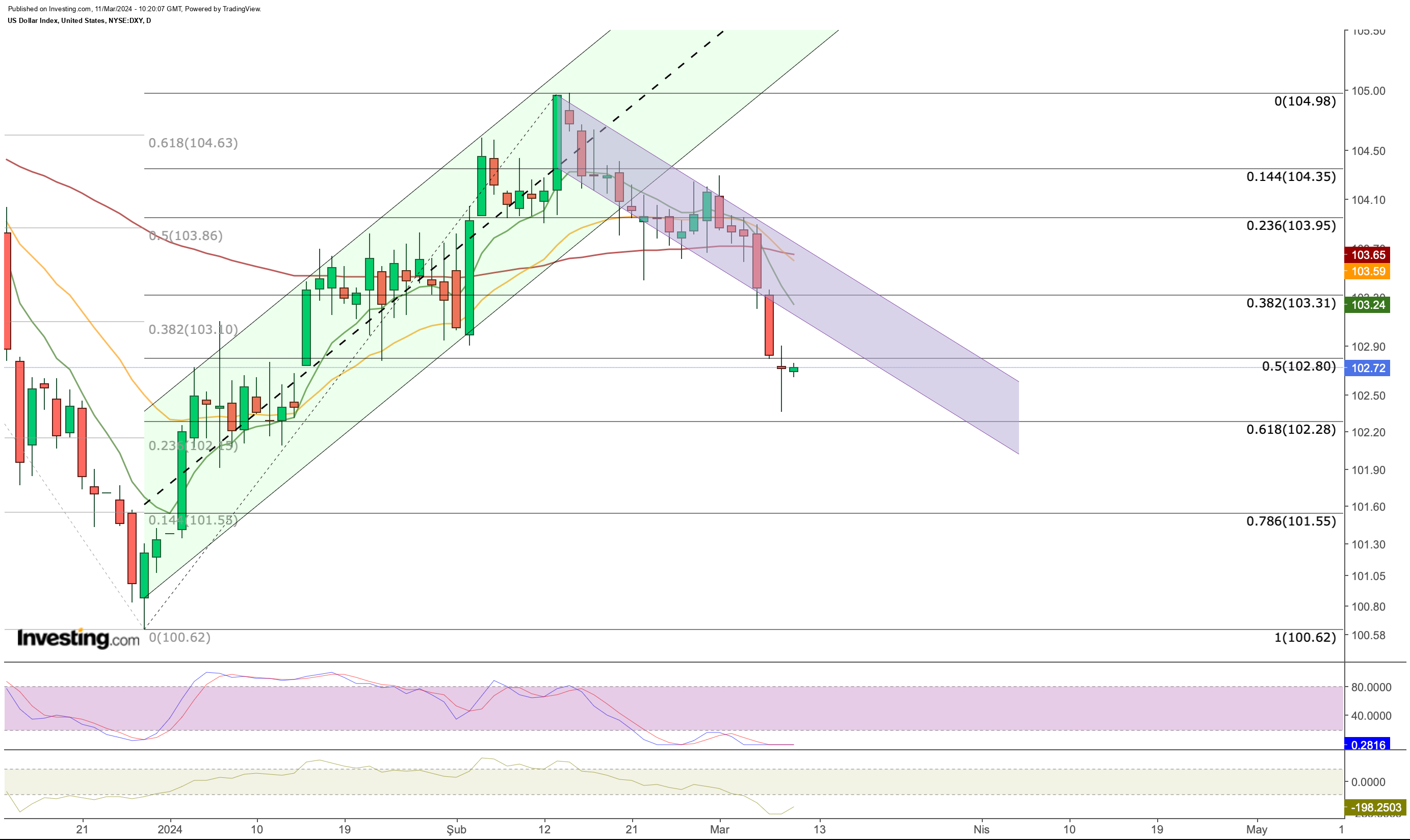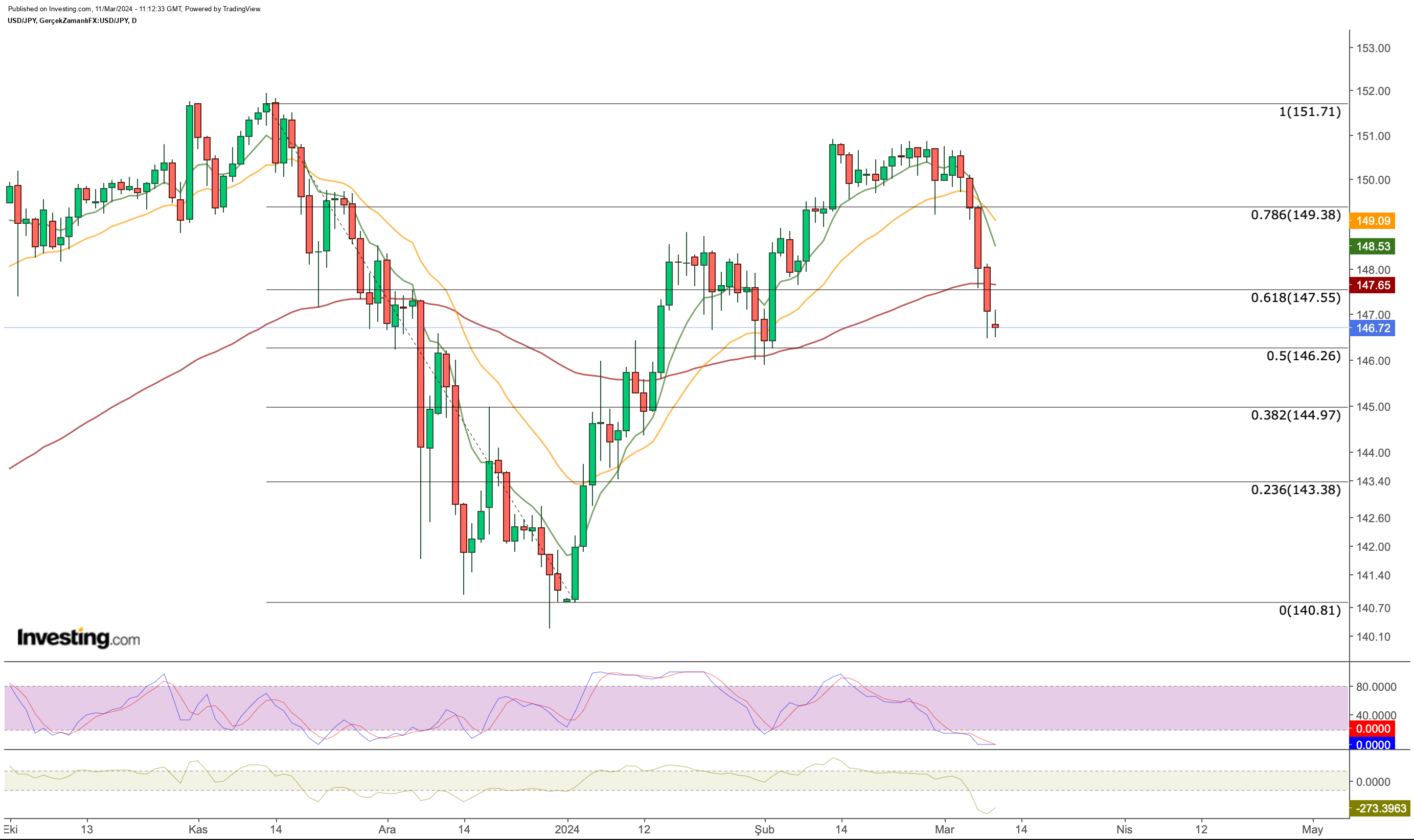- Last week, the dollar faced selling pressure, reaching its lowest level in 7 weeks after the nonfarm payrolls data.
- Concerns about potential interest rate cuts by the Fed led to a correction, but mixed data on Friday stabilized the dollar around 102.7, preventing further decline.
- The focus this week is on inflation data and ahead of the release, we will analyze probable movements in US dollar pairs like EUR/USD and USD/JPY.
- Invest like the big funds for less than $9 a month with our AI-powered ProPicks stock selection tool. Learn more here>>
Last week, the dollar faced selling pressure, dropping to the 102 level after the employment report.
Despite the nonfarm payrolls data coming in above expectations, concerns about potential interest rate cuts by the Fed in the summer led to a correction in the DXY, as the index reached its lowest level in 7 weeks.
However, after Friday's mixed data, a knee-jerk reaction led to a dollar selloff.
While the stock market also saw some selling pressure, there was a minute uptick in dollar demand which prevented further declines as the US dollar stabilized around 102.7.
Despite last week's employment data pushing the dollar index lower, it managed to find support around the 102 region.
The spotlight for this week is on inflation data, particularly the US CPI data scheduled for release tomorrow.
Fed members have been talking about making decisions based on data, but Chicago Fed's Goolsbee took a dovish stance recently.
He suggests that if inflation inches towards the 2% target, the Fed might start considering cutting rates sooner.
This contributed to a weakened outlook for the dollar. However, the market still doesn't see a rate cut in March and April as likely.
The expected announcement of CPI at 3.1% YoY, consistent with the previous month, and core inflation at 3.7% YoY, down 2 percentage points from last month, might support the Fed's higher-for-longer view.
This could result in fewer rate cuts this year, increasing demand for the dollar.
Technically, the dollar index, which has been on a downward trend for about a month, rising above 102.8 could indicate a pause in the downward trend. The next move might be towards the 103.6 - 104 range.
However, if tomorrow's inflation data aligns with or falls below expectations, supporting the Fed's target, the dollar could face rapid downward pressure. This might lead to a steep decline, accelerating towards 101.5 levels below the 102.3 support.
EUR/USD: Resistance at 1.0975 Under Scrutiny
EUR/USD, supported by the weak outlook in the dollar over the last month, rose from 1.07 to 1.1 during this period.
The euro's recovery against the greenback comes despite expectations that the ECB may cut rates sooner and faster than the Fed.
The Eurozone is expected to see a rate cut in June, as indicated by the ECB members' rhetoric. The euro initially tested a crucial resistance at 1.975 against the dollar but quickly retreated, leading to a sideways trend.
This week, we'll be keeping a close eye on the resistance level at 1.0975 for EUR/USD. The pair might maintain a sideways movement, finding support around 1.0925.
If there's sustained demand for the euro, a weekly close above the 1.09 resistance could prompt a test of the recent peak at $1.11.
The upcoming CPI data, set to be announced tomorrow, will significantly impact the pair. The volatility of EUR/USD may increase depending on whether inflation aligns with expectations.
USD/JPY May Approach 150 Level Once Again
Last week, the USD/JPY gained significantly against the dollar as the BOJ hinted at a possible negative interest rate hike. This caused a 2% drop in the USD/JPY pair, playing a big role in the overall decline of the DXY.
Recent developments suggest that the BOJ might increase its policy rate from negative this month.
This expectation has led to a rise in demand for Japanese bonds, causing the 10-year bond yield to reach a three-week high on the last business day of the week.
The growing anticipation of Japan raising interest rates, following an extended period of ultra-low rates, coupled with the certainty of the US and Europe cutting interest rates this year, continues to bolster the demand for the yen.
Additionally, an upward revision in Japan's Q4 GDP figures has further supported the currency.
In the past week, the USD/JPY pair broke the support at 147.5 and moved towards the next support level at 146.25.
This level, likely to be tested this week, previously acted as a support point in February, and the pair experienced a sharp rise to the 150 yen zone.
With the upcoming announcement of US CPI data, there is a possibility of a sudden surge in dollar demand. Depending on this momentum, USD/JPY may once again approach the 150 level.
On this trajectory, short-term resistances can be observed at 147.5 and 149.4 levels. In the lower region, the likelihood of USD/JPY descending towards 143 below the 146 level will increase.
***
Be sure to check out InvestingPro to stay in sync with the market trend and what it means for your trading. As with any investment, it's crucial to research extensively before making any decisions.
InvestingPro empowers investors to make informed decisions by providing a comprehensive analysis of undervalued stocks with the potential for significant upside in the market.
Subscribe here for under $9/month and never miss a bull market again!
Disclaimer: This article is written for informational purposes only; it does not constitute a solicitation, offer, advice, or recommendation to invest as such it is not intended to incentivize the purchase of assets in any way. I would like to remind you that any type of asset, is evaluated from multiple points of view and is highly risky and therefore, any investment decision and the associated risk remains with the investor.





